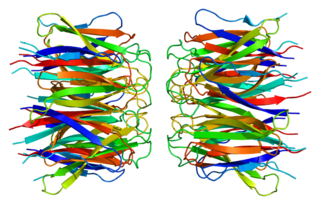
The salivary glands in many vertebrates including mammals are exocrine glands that produce saliva through a system of ducts. Humans have three paired major salivary glands, as well as hundreds of minor salivary glands. Salivary glands can be classified as serous, mucous, or seromucous (mixed).

Stathmin, also known as metablastin and oncoprotein 18 is a protein that in humans is encoded by the STMN1 gene.

Nucleophosmin (NPM), also known as nucleolar phosphoprotein B23 or numatrin, is a protein that in humans is encoded by the NPM1 gene.

Vasodilator-stimulated phosphoprotein is a protein that in humans is encoded by the VASP gene.

Myristoylated alanine-rich C-kinase substrate is a protein that in humans is encoded by the MARCKS gene. It plays important roles in cell shape, cell motility, secretion, transmembrane transport, regulation of the cell cycle, and neural development. Recently, MARCKS has been implicated in the exocytosis of a number of vesicles and granules such as mucin and chromaffin. It is also the name of a protein family, of which MARCKS is the most studied member. They are intrinsically disordered proteins, with an acidic pH, with high proportions of alanine, glycine, proline, and glutamic acid. They are membrane-bound through a lipid anchor at the N-terminus, and a polybasic domain in the middle. They are regulated by Ca2+/calmodulin and protein kinase C. In their unphosphorylated form, they bind to actin filaments, causing them to crosslink, and sequester acidic membrane phospholipids such as PIP2.

Serglycin, also known as hematopoietic proteoglycan core protein or secretory granule proteoglycan core protein, is a protein that in humans is encoded by the SRGN gene. It is primarily expressed in hematopoietic cells and endothelial cells, and is the only known intracellular proteoglycan.

Xaa-Pro dipeptidase, also known as prolidase, is an enzyme that in humans is encoded by the PEPD gene.

Cystatin-S is a protein that in humans is encoded by the CST4 gene.

Histatin 3, also known as HTN3, is a protein which in humans is encoded by the HTN3 gene.

Statherin is a protein in humans that is encoded by the STATH gene. It prevents the precipitation of calcium phosphate in saliva, maintaining a high calcium level in saliva available for remineralisation of tooth enamel and high phosphate levels for buffering.

Basic salivary proline-rich protein 1 is a protein that in humans is encoded by the PRB1 gene.

Histatin-1 is a protein that in humans is encoded by the HTN1 gene.

Basic salivary proline-rich protein 4 is a protein that in humans is encoded by the PRB4 gene.

Basic salivary proline-rich protein 3 is a protein that in humans is encoded by the PRB3 gene.

Salivary acidic proline-rich phosphoprotein 1/2 is a protein that in humans is encoded by the PRH1 gene.
FDC-SP or follicular dendritic cell-secreted protein, is a small, secreted protein, located on chromosome 4 in humans. It is thought to play an immune role in the junctional epithelium at the gingival crevice in the human mouth. It is very similar in structure to statherin, a protein contained in saliva.
Histatins are histidine-rich (cationic) antimicrobial proteins found in saliva. Histatin's involvement in antimicrobial activities makes histatin part of the innate immune system.

Synapsin I, is the collective name for Synapsin Ia and Synapsin Ib, two nearly identical phosphoproteins that in humans are encoded by the SYN1 gene. In its phosphorylated form, Synapsin I may also be referred to as phosphosynaspin I. Synapsin I is the first of the proteins in the synapsin family of phosphoproteins in the synaptic vesicles present in the central and peripheral nervous systems. Synapsin Ia and Ib are close in length and almost the same in make up, however, Synapsin Ib stops short of the last segment of the C-terminal in the amino acid sequence found in Synapsin Ia.
Proline-rich proteins (PRPs) is a class of intrinsically unstructured proteins (IUP) containing several repeats of a short proline-rich sequence.

Proline-rich protein 30 is a protein in humans that is encoded for by the PRR30 gene. PRR30 is a member in the family of Proline-rich proteins characterized by their intrinsic lack of structure. Copy number variations in the PRR30 gene have been associated with an increased risk for neurofibromatosis.













